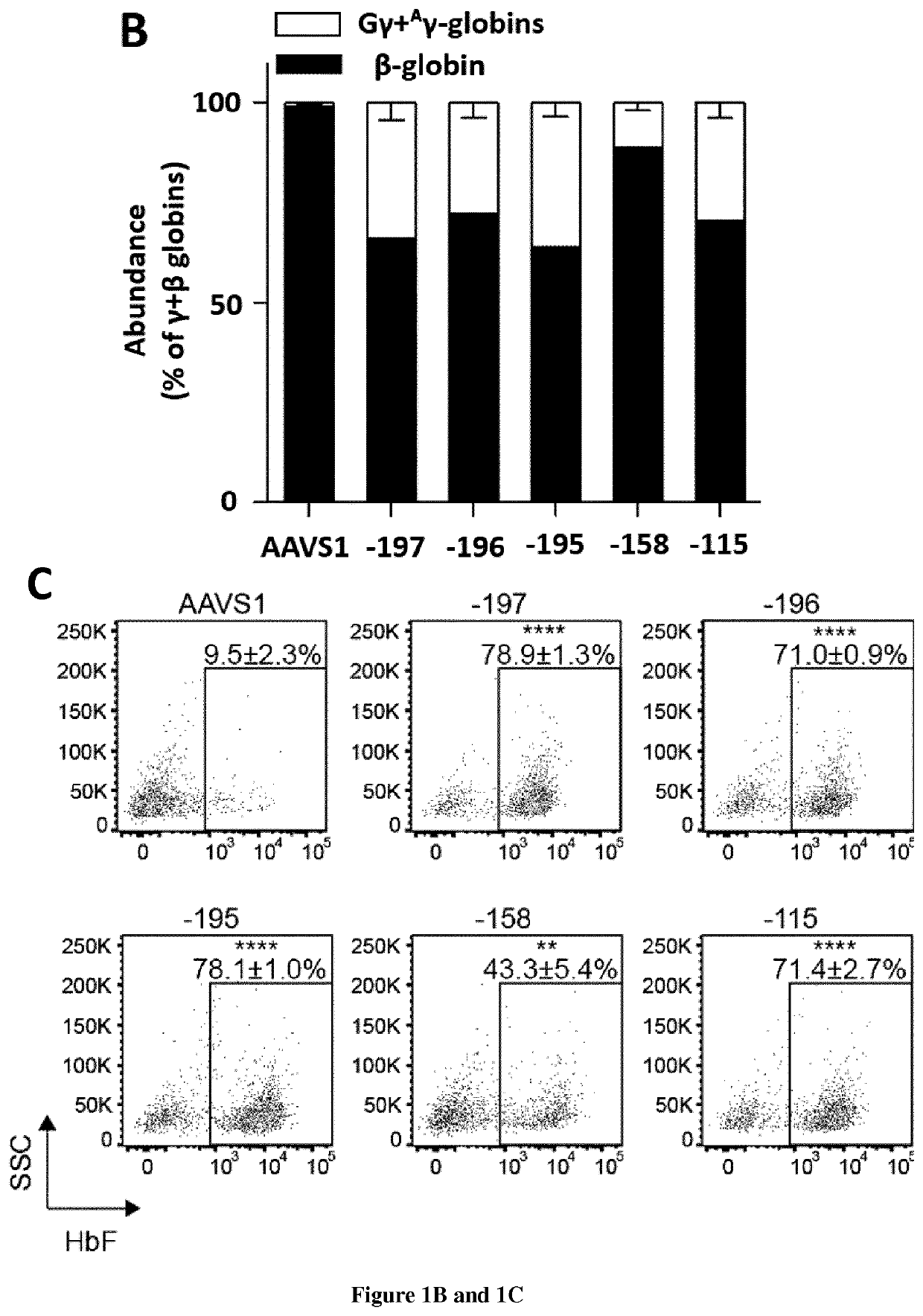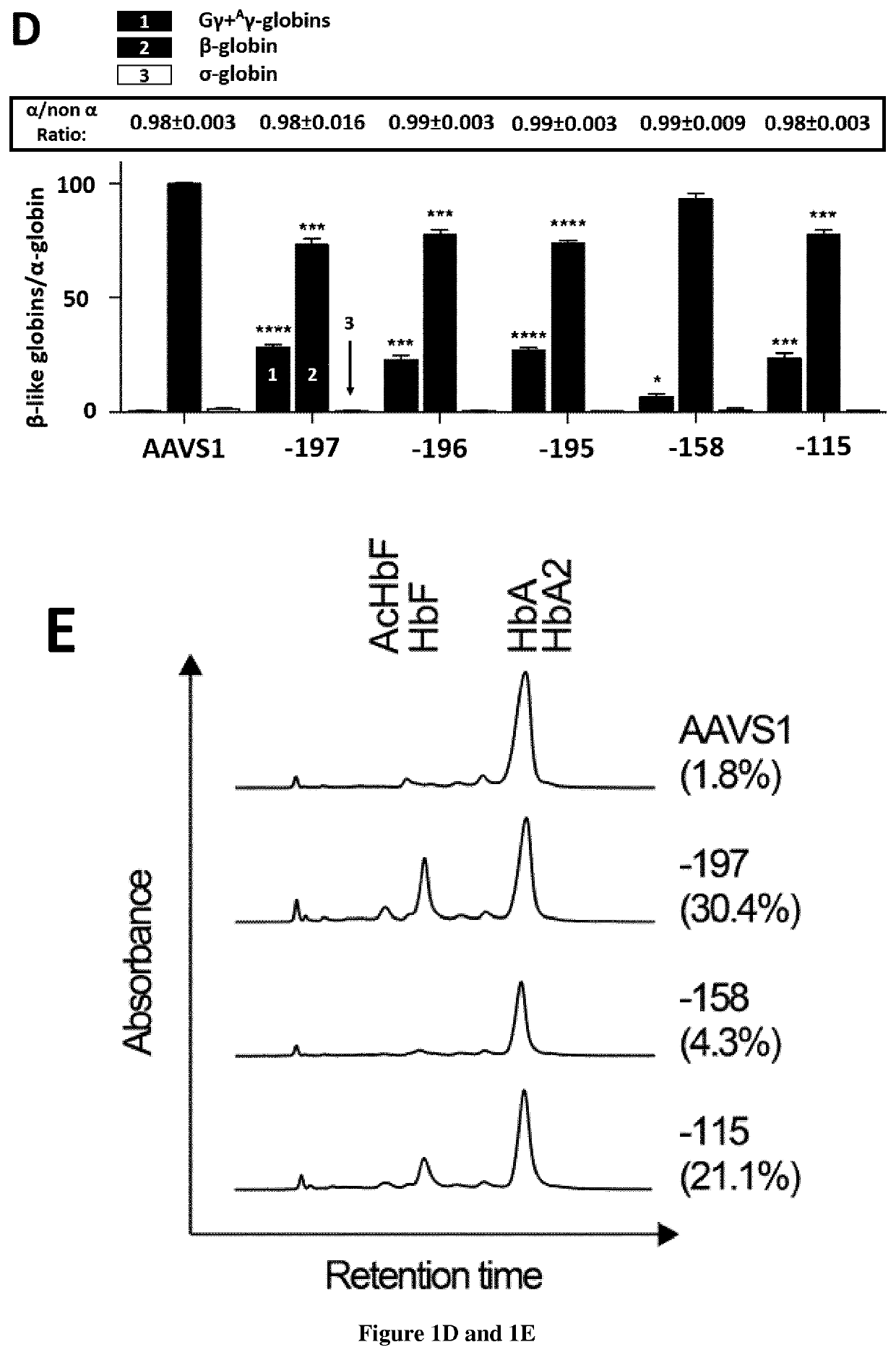Methods for increasing fetal hemoglobin content in eukaryotic cells and uses thereof for the treatment of hemoglobinopathies
a technology of fetal hemoglobin and eukaryotic cells, which is applied in the field of increasing fetal hemoglobin content in eukaryotic cells, can solve the problems of insufficient hemoglobinization of red blood cells, ineffective erythropoiesis, and precipitation of -globin, and achieve the effect of increasing the fetal hemoglobin conten
- Summary
- Abstract
- Description
- Claims
- Application Information
AI Technical Summary
Benefits of technology
Problems solved by technology
Method used
Image
Examples
example 1
[0098]Targeting Multiple Regions in the HBG Promoters Induces HbF Expression in Adult HUDEP-2 Erythroid Cells
[0099]HPFH mutations and SNPs associated with high HbF levels have been described in multiple regions of the HBG promoters (−200, −158 and −115; FIG. 1A). HPFH mutations in the −200 and −115 regions alter the binding of transcriptional repressors2. We hypothesized that disruption of these regions via CRISPR / Cas9 could potentially lead to HbF de-repression. We designed guide RNAs (gRNAs) binding the −200 (−197, −196 and −195) binding site of the HbF repressor LRF and the −158 region (−158, −152 and −151). In parallel, we used a gRNA targeting the −115 region and leading to HbF reactivation in adult HUDEP-2 erythroid cell line and HSPC-derived RBCs7, likely by disrupting a binding site for the HbF repressor BCL11A2 (FIG. 1A). Plasmid delivery of individual gRNAs and a Cas9-GFP fusion in fetal erythroleukemia cell line K562 revealed a similar editing efficiency for the three gRN...
example 2
[0113]We then compared the activity of 3 gRNAs targeting the LRF binding site in CD34+ HSPCs obtained from SCD patients by plerixafor mobilization. SCD HSPCs were transfected with RNP complexes containing either the gRNAs targeting the HBG promoters or the control AAVS1 gRNA. Following erythroid differentiation, genome editing efficiency in mature erythroblasts achieved values of ≥80% in cells transfected with −197, −196, −195 and −115 gRNAs (data not shown). Editing frequency with the −158 gRNA was variable because of the presence of the C>T SNP at that position in a fraction of the SCD donors (data not shown). Genome editing efficiency was similar between the HBG2 and HBG1 promoters except for samples harboring the −158 SNP and treated with the −158 gRNA (data not shown).
[0114]Control and edited SCD HSPCs were plated in clonogenic cultures (colony forming cell [CFC] assay) allowing the growth of erythroid (BFU-E) and granulomonocytic (CFU-GM) progenitors. Genome editing efficiency...
PUM
| Property | Measurement | Unit |
|---|---|---|
| Content | aaaaa | aaaaa |
| Level | aaaaa | aaaaa |
Abstract
Description
Claims
Application Information
 Login to View More
Login to View More - R&D
- Intellectual Property
- Life Sciences
- Materials
- Tech Scout
- Unparalleled Data Quality
- Higher Quality Content
- 60% Fewer Hallucinations
Browse by: Latest US Patents, China's latest patents, Technical Efficacy Thesaurus, Application Domain, Technology Topic, Popular Technical Reports.
© 2025 PatSnap. All rights reserved.Legal|Privacy policy|Modern Slavery Act Transparency Statement|Sitemap|About US| Contact US: help@patsnap.com



